
It’s time for our last Victoria recap of the season, magpies! Today, we’re looking at the history and the jewels depicted on the season’s Christmas special, “Comfort and Joy.” (You can catch up on our previous recaps over here!)

We begin in West Africa, in the Kingdom of Dahomey, which is located in present-day Benin. A little girl, Aina, sits in a cage while King Ghezo argues with a British soldier, Captain Forbes about her fate. (The slave trade was a significant part of Dahomey’s economy, and, to reduce a very complicated bit of history to part of a sentence, British ships blockaded the country’s ports in the 1850s as a way to try to stop it.) Ghezo agrees to let Forbes, who tries to spook him with tales of the “Great White Queen” he serves, take the child as a “gift” for Victoria. (This plotline is based on a real event from 1848.)

In London, Queen Victoria wears teeny jewels as she pensively plays the piano. Albert comes in an asks her to play something more festive. He LOVES Christmas.

No, he REALLY loves Christmas. He fairly dances around the palace, bellowing “O Tannenbaum” and deciding where all of the decorations should be arranged. He gleefully tells the clueless English residents of the palace, including Victoria, why the Germans put up Christmas trees. Holidays and historical lectures — Albert’s favorite!

Victoria, who is wearing dangling earrings and bejeweled hair combs, is frankly quite amused by all of it.

In Hampshire, the little girl from Dahomey is also playing carols at the piano, with Captain and Mrs. Forbes smiling over her. She has been renamed Sarah — in real life, Forbes called her Sarah Forbes Bonetta, after his ship, the HMS Bonetta.

Charlotte Buccleuch reads over the lists of Christmas gifts that Victoria has received, while Wilhelmina (who appears to be wearing a necklace in her hair) makes eyes at the grieving Lord Alfred. Charlotte also tells Victoria that she’s gotten a letter from Forbes, letting her know that he has a gift for her.

We get a good look at Victoria’s brooch and ring as she tells Charlotte that Forbes should bring the gift to her. She guesses that it’s a baby elephant. (Nope. Also — Victoria’s expecting another actual baby. I think that makes this number four, Prince Alfred, although the wonky historical timeline of the show makes it tough to keep track. Affie was born in August 1844.)

Surprise! Victoire Kent and Uncle Leopold are waiting in the music room, where they show off a guest: Princess Gertrude von Mecklenburg-Strelitz, another fictional plot device designed to prolong the soapy fictional relationship between Ernst and Harriet.
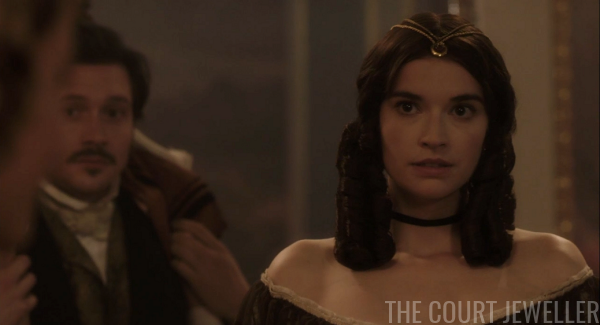
Speaking of Harriet, she’s gone full ferronniere again, and she’s ticked about this new royal addition to court.
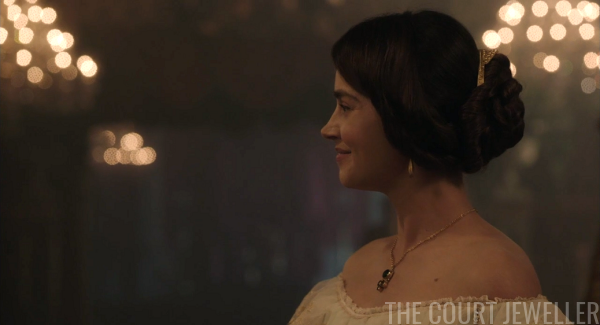
Victoria’s just not thrilled about any of this — especially when her mother also reveals that she’s brought her a parrot to replace the recently departed Baroness Lehzen. Subtle, Victoire!
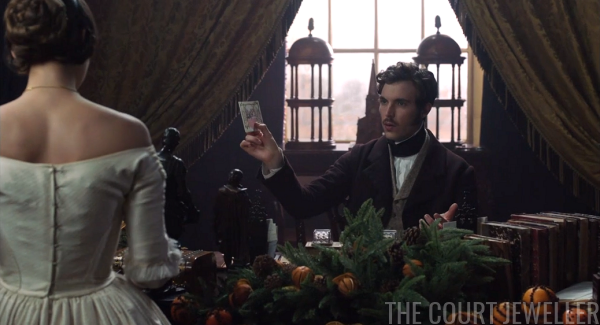
Albert’s Christmas mania continues unabated, this with a fit of controlled Germanic delight over a newfangled innovation: a printed Christmas card!

But Victoria, wearing a very cool bejeweled hair-band-thing, is way less interested in his holiday paraphernalia and way more interested in why he decided to invite her mother to the palace. It’s Christmas, he protests, and family members are supposed to be around. He did it for the kids!

Over the protests of his wife, who has come to love Sarah deeply, Captain Forbes brings the little girl from Dahomey to the palace. Sarah, he explains, is the last living member of the Egbado royal family, and he saved her from certain death by bringing her to England. (This is basically true.)

Victoria can’t quite wrap her head around the idea that a king has sent this little girl to her as a “present” — it clearly doesn’t feel right to her. Forbes, though, notes that Sarah’s only alive because he promised to bring her to Victoria, and he tells her what a delightful and smart little girl Sarah is. (The show, it’s worth noting, has not yet gives Sarah a single line by this point, even though we know she’s already learned English. No translating even needed.)

Victoria reiterates that she cannot accept a human being as a gift — but because Sarah is a person of royal birth, it’s only natural that she should be asked to stay at the palace. Victoire Kent mutters some disagreement about the plan, but Victoria shuts her down.

She assures Sarah that she is very welcome at the palace, and that she will be safe there. We get an excellent view of Victoria’s amethyst brooch in this scene, a production-invented piece that resembles several pieces of Victoria’s real jewelry.

The issue of slavery is also brought into the below-stairs plot of this episode, as Skerrett inherits property from a forgotten uncle in America that promises to bring her a fortune — but said property is twenty enslaved people. She has to decide whether to sell the humans that she now owns to make a life-changing profit (something in the neighborhood of ten thousand pounds) or free them. Time spent with Sarah helps Skerrett decide to free the people rather than selling them, even though the resulting sum of money would have changed her life completely. (The chef proposes to her, though, so things aren’t all terrible.)
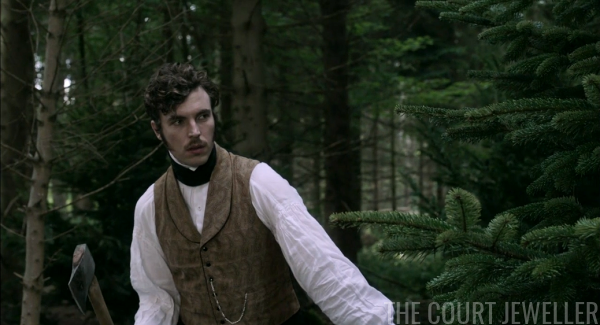
Albert and Ernst head out to the forest to hunt down the perfect Christmas tree, and we finally get a reason for Albert’s fanatical love for Christmas: his only member of his parents together involves them standing, smiling, beside a Christmas tree. (This would have been a very early memory. Albert was born in August 1819, and his mother was exiled from the Coburg court in 1824.)

Harriet and Victoria take Sarah to a toy shop, where we finally hear her speak, and she chooses a doll. Victoria tells Sarah about how much her dolls meant to her — that they were her friends as a child. Would have been nice if Harriet, who was a major anti-slavery campaigner in real life, had been given a bigger role in this part of the plot, wouldn’t it? She would have had SO MUCH to say about Dahomey and the legacy of the entire slave trade.

Instead, Harriet is relegated to the soapy plot about Ernst’s courtship of Princess Gertrude, even though a) Ernst was already married to Princess Alexandrine, b) Harriet wasn’t widowed at this point, c) Gertrude is fictional, d) Ernst STILL has syphilis, e) no one’s running Coburg, and f) this entire show, with its desire to be sometimes treated a serious historical drama, is wearing me down.

Charlotte Buccleuch (who, it’s worth reminding everyone, was really in her mid-thirties at this time) is cranky, too. She grumbles about everything. Victoria has brought an African child into the palace. Albert wants to hang a Christmas tree from the ceiling. What IS the world coming to? She also barks at Fictional Wilhelmina about the dangers of becoming an old maid. She’s clearly the Scrooge of this Victorian Christmas.

Fictional Wilhelmina is shocked when Aunt Charlotte suggests that she should set her cap for Lord Alfred, but Charlotte explains that “men like Lord Alfred” make perfectly good husbands. This entire storyline is just mind-boggling.

Victoria, wearing a cameo pin, argues with Albert over Sarah’s place in the palace nursery. He worries that Sarah is unhappy. Victoria says that Sarah just needs to get used to them. No one asks Sarah what she thinks.

In fact, we later see Sarah crying alone in her bed at night. The poor girl has lost her family, been removed from her home, had her name changed, and then been removed to yet another unfamiliar place.

Uncle Leopold finds out that Ernst is suffering from the old family ailment. Leopold thinks that Ernst should marry a princess, preferably the Fictional Gertrude, regardless. Ernst is appalled.

That night, everybody goes to the opera to see Rossini’s La Cenerentola.

And everybody includes the King of Hanover, whom we haven’t seen since last season. What’s up, Cumberland? (Unless they’re all traveling incognito, how do all these foreign monarchs keep showing up and surprising Victoria? Besides, Ernst August made precisely one trip to England after heading off to Hanover: he visited in June 1843, in part to attend the wedding of his niece, Princess Augusta of Cambridge.)

Victoria, who wears production-invented jewels, including a ruby tiara, is concerned.

After the performance, Uncle Cumberland shows up in the royal box, where he chats happily to his old friend “Mathilde” — the Duchess of Buccleuch. (WHY didn’t the production just INVENT a duchess, if they insist on changing every single thing about her, including her first name?) He asks if she remembers the diamond necklace that Queen Charlotte once wore.

Victoria’s hands fly to the necklace, which she’s wearing. (This production-invented necklace doesn’t look anything like Charlotte’s real necklace — and it also looks pretty silly with all of that golden jewelry.)

She’s also got a second diamond necklace (which looks like a modified fringe) in her hair. Uncle Cumberland promises to come and see her at the palace.

Post-opera, Wilhelmina provides comforting conversation to Alfred while wearing a pearly headband/tiara/ornament.

Victoria frets about Uncle Cumberland and his reasons for visiting. Albert, still full of Christmas spirit, says that surely he’s just here to visit his family for the holidays. (Okey-dokey, Al.) Speaking of family: Victoria’s planning on adopting Sarah, who has been crying after another nightmare. Albert thinks this is all a very bad idea.

When they wake up the next day, London is a winter wonderland. The family goes out to play in the snow. Victoria teaching Sarah how to build a snowman, but Sarah is distant. (There’s something vaguely “Do They Know It’s Christmas” about this entire storyline, and it’s a little bothersome, to be honest.)

The merriment is interrupted when Uncle Cumberland arrives at the palace, demanding the return of his mother’s diamond necklace. Victoria tells him to stuff it and kicks him out of the palace. Later, she and Albert argue over the necklace; he thinks it’s just an object and she should hand it over, while she sees the entire dispute as a representation of all of the suffering that Cumberland put her through as a child.
So, the Hanoverian Claim is officially on. In real life, the King of Hanover laid claim to Queen Charlotte’s jewels starting in 1837, almost immediately after Victoria’s accession, not 1843/1848/whenever this episode is supposed to take place. It took more than two decades to litigate the claim, which included way more jewels than just one necklace. Ernst August was dead by the time the jewels were awarded to his son.

That evening, Sarah sneaks into Victoria’s rooms to see the other being in the episode that has been caged: the parrot brought by the Duchess of Kent. She whispers to the bird in her native language, asking if it also misses home. And then she hears Victoria crying softly. The tables turn as Sarah tries to comfort the Queen, telling her about Mrs. Forbes.

Later, Sarah hides under her bed and writes a tear-stained letter to Mrs. Forbes, whom she misses dearly.

Victoria rallies, wearing simple jewels (including a necklace as a ferronniere) to open the dancing at the servants’ ball below stairs.

As the ball carries on, Harriet sneaks into Ernst’s room to seduce him. She is very close to being successful, but then he remembers, you know, the VD. Instead of telling her about his situation, though, he just says that he’s not that into her. Cold as ice.

Instead of going back to her room, Harriet decides to deal with a whole lot of feelings in the hallway on the production’s Designated Crying Bench for Courtiers, where the King of the Belgians is able to stumble upon her in her nightclothes. He actually asks if she’s been fooling around with Ernst, and then he actually tells her about Ernst’s syphilis! This might be the very, very weirdest scene of this ENTIRE show, and that is SAYING SOMETHING. (Oh, and by the way, Fictional Gertrude has gone back to Germany, which is just as well, because she’s imaginary.)

The next morning, Wilhelmina (in the same clothes and Hair Necklace) as earlier in the episode, tracks down Lord Alfred to give him a not-at-all-awkward present: a lock of Drummond’s hair. The locket holding said lock is decorated with that reference to the friendship of David and Jonathan from a previous episode. Subtle, Fictional Wilhelmina.

And then, well, this happens. Lord Alfred proposes, Fictional Wilhelmina accepts, and the rest is history. (Except, of course, that it’s not. Unlike Wilhelmina, Alfred was a real person, and in 1847, he married Cecilia Wyndham. They had fourteen children. Fourteen!)

Meanwhile, Albert is VERY pleased with the progress of his Christmas decorating extravaganza. But Victoria is displeased, because each of the children have their own Christmas tree — except for Sarah. They argue over whether Sarah is part of the family.

Wearing the itsy-bitsy Albert Brooch, Victoria tells her husband that she thinks Christmas is really about showing kindness “to someone who has nothing.” He points out that Sarah already has another home, with the Forbes family in Hampshire. Albert thinks this all boils down to one thing: Victoria has issues with her own mother. She vehemently disagrees.

Hiding just out of sight, little Sarah hears the whole argument.

Albert soon musters up his Christmas spirit again, and he’s merrily playing Christmas carols when Ernst drops in — and starts playing with one of the delicate Christmas ornaments that Albert had commissioned from Bohemia, causing PANIC from the Christmas Prince himself. He goes back to playing the piano, and the Grinch of Saxe-Coburg and Gotha smashes the ornament on purpose, just to spite him. WILL NO ONE LET ALBERT ENJOY HIS FANCY CHRISTMAS?
Ernst certainly won’t. He tells Albert that his beautiful Christmas memory from Coburg was also the night that their mother was sent away for good, bursting the heck out of Albert’s nostalgia bubble. But then, Albert takes a deep breath, says that his memory is still a good, perfect Christmas moment, and he doesn’t even care what Ernst says.

Victoria goes to look for Sarah, who is missing from the nursery. Out in the snow, she follows footprints, only to discover that they belong to Albert, who is furiously skating away his anxiety on the frozen pond. And then, he falls through the ice.

After a mighty struggle, Victoria manages to pull him back to the surface.
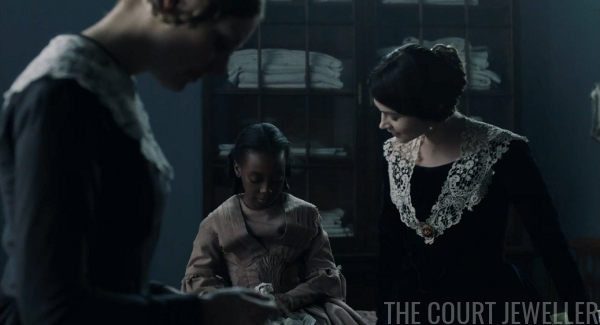
Back at the palace, Victoria finally finds Sarah below stairs with Mrs. Skerrett, playing with her doll. Victoria asks what the doll’s name is, and Sarah says that it’s “Aina” — Sarah’s real name. Victoria asks if Aina would like to see Captain Forbes, and Sarah — Aina — says that she’d like to see Mrs. Forbes.

The little girl and Mrs. Forbes are happily reunited. Victoria offers continued support, but she knows that Sarah will be much happier in Hampshire.
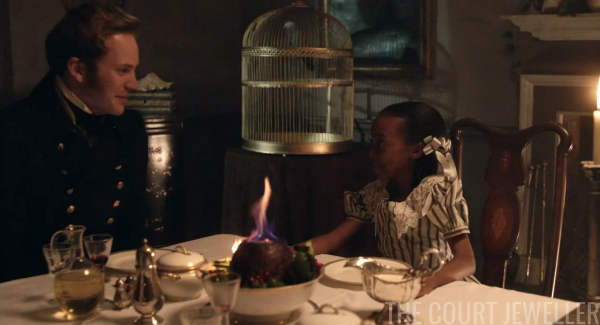
Sarah, the Forbeses, and the parrot have a happy Christmas in Hampshire. (In real life, Victoria served as Sarah’s godmother. Sarah returned to Africa for four years to attend school, but she came back to England in 1855. She was a guest at Princess Alice’s wedding in 1862, and, with Victoria’s permission, she married Captain James Pinson Labulo Davies in Brighton later the same year. She and Victoria maintained a friendship for the rest of her life.)

Back in London, Ernst stops by Albert’s palace holiday pop-up shop to apologize for being such a jerk earlier. He explains that he’s angry, because he’ll never be able to have a family, because of the stupid syphilis. Albert feels terrible for him.

Harriet tells Ernst that she knows about “the mercury.” He tells her that their relationship is simply “star-crossed.” I’d go with “entirely fictional,” but sure.
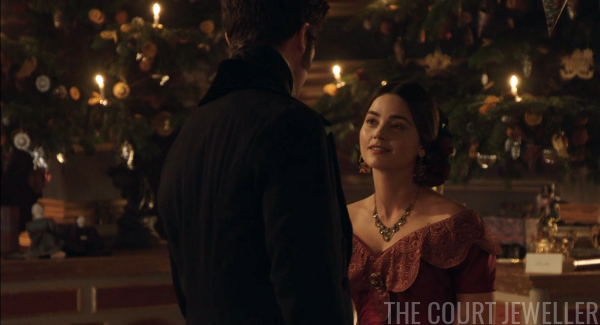
Victoria and Albert put the final touches on his Magical Christmas Bonanza before the family comes in on Christmas Eve. (If Albert were around today, you know he’d be competing for the best Christmas light display on the block.) As an extra little screw you to Uncle Cumberland, Victoria wears her diamond necklace for the occasion. (Better not get too attached, Vic.)

And it is magical, indeed. Fictional Wilhelmina even gets a special present: a fictional engagement ring!

At Christmas dinner, tiaras are the order of the evening. Wilhelmina wears her pearly headband thing…

…while Victoire goes with mourning jewels in fashionable jet. (Is she supposed to still be in mourning for her brother? Sibling mourning periods weren’t that long. And she wore regular jewels last season. I’m perplexed.)
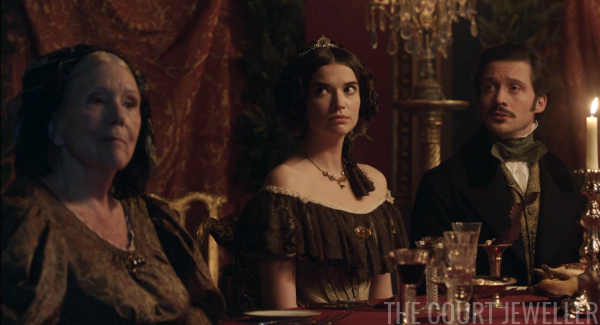
Harriet wears a little gold tiara, while Charlotte apparently didn’t get the jewelry memo.

Victoria goes for diamonds. (This little circlet looks especially fake, doesn’t it?)

The party has a crasher, though: it’s Uncle Cumberland! He’s come to tell everyone Merry Christmas and to let Victoria know that he’s decided to forget about the diamonds after all. Consider them a Christmas present! He bids them auf wiedersehen and starts to skedaddle.

But Victoria asks him to join them for dinner. It’s all very happy merry families, but of course, none of this ever happened, the King of Hanover wasn’t in Britain for any royal Christmases, and he ABSOLUTELY never told her that he didn’t want those diamonds.
(Albert and Uncle/Father Leopold have a whisper session at the table, where they reveal that Leopold and Charlotte Buccleuch worked together to convince Cumberland to drop the claim. HA. As if.)
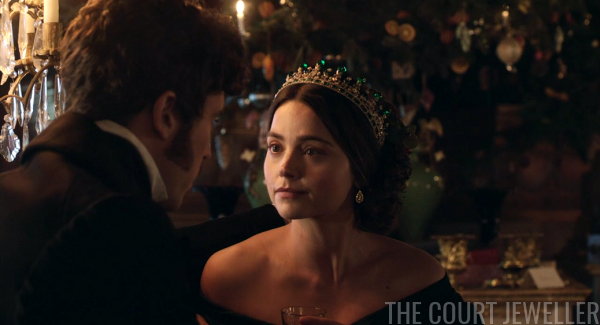
We’ve got one final bejeweled surprise of the season: after dinner, when Albert and Victoria return to their rooms, she’s sporting her diamond and emerald tiara. This is one of the jewels that Albert designed for her; you can read more about it over here! The replica isn’t terrible, but it’s too big.
Leave a Reply